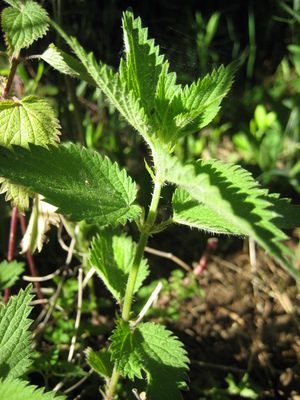Stinging nettle (Urtica dioica) is native to Europe and Asia, and grows widely throughout the United States. It is a perennial, 2-4 feet high, and prefers to grow in the moist, rich soil and partial shade of woodlands and riverbanks. The leaves and stems of nettle are covered with tiny, needle-like hairs that contain acetylcholine, formic acid, histamine, serotonin, and other compounds that cause a painful sting if touched. When harvesting nettle, make sure to wear gloves. It is best to harvest young leaves, before the plant begins to flower.
Nutritional Value of Nettles
Fresh nettle can be steamed and eaten as a vegetable, similar to spinach, or put into soups. Nettle tea is made by infusing dried nettle leaves in hot water. Once the leaves and stems are cooked or dried, the sting is neutralized and it doesn’t hurt to touch them. Nettle is high in nutritional value, and contains several minerals including iron, magnesium, calcium, potassium, boron and silicon, as well as vitamin A, B complex and beta-carotene.
Nettle has traditionally been used as a spring tonic to detoxify and invigorate the body after the long winter months.
Medicinal Properties of Stinging Nettle
Nettle has numerous medicinal properties. Its expectorant properties make it good for lung congestion, coughs and bronchitis. It also has antihistamine and anti-inflammatory activity that aids in relieving symptoms of asthma and hayfever. Its anti-inflammatory activity, as well as its high amounts of boron and silicon, aid in reducing swelling and pain associated with arthritis, tendonitis and bursitis. The calcium and boron in nettle also strengthen bones, making it beneficial for osteoporosis.
The diuretic properties of nettle make it useful to relieve symptoms of excess water retention. Because it promotes more complete emptying of the bladder during the day, the need to get up to urinate during the night decreases and it helps to alleviate bedwetting.
Nettle root has been shown to relieve symptoms of benign prostatic hyperplasia (BPH), an enlargement of the prostate gland in men.
Drinking nettle tea is beneficial to the hair and skin, and helps to clear up skin conditions such as eczema. Externally, it can be used as an astringent for the face, or added to homemade shampoos and conditioners.
Nettle’s sting is sometimes actually considered a medicinal property. Urtication is the process of gently tapping an area of the body with fresh nettle. Why would anyone want to do this? Stinging nettle acts as a counter-irritant. According to the University of Maryland Medical Center website, if stinging nettle is applied to the skin at a location that is hurting, such as a joint that is swollen and painful due to arthritis, the original pain will be reduced. This is thought to be due to a reduction of the body’s inflammatory chemicals and changing the way pain signals are transmitted. In his book, Medical Herbalism, herbalist David Hoffman states that this treatment will reduce the stiffness and swelling for several days.
Contraindications and Cautions
Since nettle is a diuretic, it may enhance the effects of diuretic drugs. Nettle may lower blood sugar and decrease blood pressure, so it may interfere with drugs taken for diabetes and high blood pressure. Nettle also affects blood clotting, and may interfere with blood-thinning drugs.
This information is for educational purposes only. If you have a health concern, see your health care provider.
Sources:
Hoffman, David. Medical Herbalism. Healing Arts Press, 2003.
Duke, James A. The Green Pharmacy Herbal Handbook. St. Martin’s Paperbacks, 2000.
http://www.umm.edu/altmed/articles/stinging-nettle-000275.htm
http://www.wildmanstevebrill.com/Plants.Folder/Nettle.html




